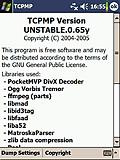Sat June 25 2005
 eReader 'Everyday in July' Promotion eReader 'Everyday in July' Promotion
|
|
01:06 PM by Dick Tracy in E-Book General | Deals and Resources (No...
|
|
[ 13 replies ] |
Fri June 24 2005
 Stephenson's "The Cobweb" with 100% Micropay rebate Stephenson's "The Cobweb" with 100% Micropay rebate
|
|
07:50 PM by Alexander Turcic in E-Book General | Deals and Resources (No...
From the inside flap: |
|
[ 0 replies ] |
 Why PalmSource May Be Right About Multitasking Why PalmSource May Be Right About Multitasking
|
|
06:03 PM by Bob Russell in Archive | Handhelds and Smartphones If you've followed any of the discussions comparing Pocket PC and PalmOS devices, you know that the three topics almost guaranteed to come up are:
These points will continue to be debated ad infinitum, and to be honest it's a lot of fun! But today I want to give a perspective on the third item that I don't think has really been discussed much. As you probably know, I recently moved from a Toshiba Pocket PC to a Treo 650, and I really like it. But I found myself wishing it had multitasking like the Pocket PC did. Instead of just stopping there, I decided to think it through a little bit further and was surprised at what I came up with. So I asked myself, "Why do I miss the multiple applications running like in Pocket PC?" For example, Cobalt is supposed to have true preemptive multithreading/multitasking or whatever you want to call it, which is really not so far off from what a desktop OS might do. And it sounds like with PalmOS for Linux, some of the thread and context limitations from the OS may be lifted also. I suppose that the future of Linux kernel, improvements in the Linux kernel, and better hardware CPU support will allow this to become even more robust. It's necessary, I suppose, to handle things like cell calls while doing wifi and bluetooth, and doing various other background computing for whatever reason. But I'm neither an expert on this, nor am I really all that concerned about learning the details. It's all very interesting to me for a moment when a clear explanation is given, and then someone goes and brings up a new angle and puts me back in my natural state of confusion all over again! But my point is that we need to follow PalmSource's advice and look at what the user sees and needs on a handheld device. Their argument is that you really don't do two applications at once on the screen anyway. You have an application on the screen, and then you may have various other things happening in threads for a toolbar, an mp3 player, a pop up window activity, etc. If you really go to another application the screen switches, and you really don't need to know whether or not that first application is still runnning or not. You just want to be able to go back to it when you choose to. Aha! That's the whole problem, isn't it?! Here's why I say PalmSource may be exactly right about multitasking. They are completely right in this regard -- While we need background processes, we really don't care whether or not we have a bunch of screen-filling applications running at once if we are only using one at a time. In fact, managing what programs are running on Windows Mobile is one of the biggest annoyances leading to a third-party essental utility as an add-on to keep you from throwing the device out the window and hitting your neighbor in the head! But, somehow, we haven't seen that PalmSource philosophy come through into the user experience. It has become more of a justification for the way PalmOS works than the basis for a good user experience. Let me describe what I mean by going back to what I miss about Pocket PC. I could (with Wisbar Advance) pop up a task list and easily switch to any running application. So the ones I use back and forth can be switched easily. I didn't care if they continued to run, I just wanted to be able to continue using them. I also liked continuing to use them in the same state that I left them in. Not a problem if they are still running. So it's not a multitasking issue, it's a user interface issue. And I think both Windows Mobile and PalmOS have kind of blown it so far. I'm sure they will both get better, but Windows Mobile shouldn't require an add-on to easily handle program switching and program closing. It's a headache to the user, and that's what good design is supposed to avoid, right? And with PalmOS, you shouldn't have the messy program switching that you experience. For example, on my (delightful!) Treo650, if I put an mp3 on pause from RealPlayer and switch to another application, then when I come back my track starts at the beginning again. It remembers my track, but not my position in the track when I paused it. According to what I learned in a programming class for PalmOS, that isn't how it's supposed to work. The user isn't supposed to know that the application had to restart and didn't just keep running. But the problem is that I was inconvenienced by it. Another example of how the UI can be a bit of a nuisance is when, for example, I'm happily reading something in iSilo. Then I remember something that I need to do. One of the great things about a pda is that when you remember something you can record it right on the spot and forget about it. So I go to the Tasks application to enter my todo item. So far so good. But on PPC, I can then go back to iSilo easily. Not so much because it's still running, but because there's a drop down menu that has it still listed assuming I didn't do something special to force it to close. So on PPC I just tap tap and I'm reading again. But with PalmOS (and no add-on software), I have to go to home, find iSilo and launch it. It might not seem a big deal, but for a core and common sort of action it can be a bit of a nuisance. Now don't get me wrong... it's not a big deal. It's easily solved for the most part by picking the right apps or adding third party software. And this is not meant to be fodder for people to say "I told you PPC/Palm was garbage!" But my point is that it's the UI that's the real issue in this Palm vs PPC fight over multitasking, not the technology or philosophy of the OS. I'm pretty sure that both OS's are actually quite capable. And the good news is that the UI is certain to improve quickly in both camps. |
|
[ 55 replies ] |
 Palm OS ROM update step-by-step guide Palm OS ROM update step-by-step guide
|
|
05:09 PM by Alexander Turcic in Archive | Handhelds and Smartphones A flash update is always a dangerous business if you don't follow the instruction carefully. To avoid ruining your beloved handheld, check out PalmFocus' step-by-step guide of how to perform ROM updates on various Palm OS devices. |
|
[ 0 replies ] |
 Tungsten XX leaked pics and specs Tungsten XX leaked pics and specs
|
|
12:56 PM by Alexander Turcic in Archive | Handhelds and Smartphones
This would be my favorite configuration of a Palm handheld. The LifeDrive seems to big to me, and I always liked the T5 form. Since this rumored device includes WiFi... I wouldn't hesitate buying it. |
|
[ 6 replies ] |
 Core Pocket Media Player 0.65y for Pocket PC Core Pocket Media Player 0.65y for Pocket PC
|
|
10:45 AM by Colin Dunstan in Archive | Handhelds and Smartphones
Quote from Picard: Plugins: |
|
[ 8 replies ] |
 TomeRaider for PPC 3.1.13 adds P2P client TomeRaider for PPC 3.1.13 adds P2P client
|
|
09:06 AM by Colin Dunstan in E-Book Software | Reading and Management
|
|
[ 0 replies ] |
 On cleaning LCD screens On cleaning LCD screens
|
|
09:00 AM by Colin Dunstan in Miscellaneous | Lounge
It's best to avoid household cleaners and common rags or cloths or paper products. I advise using a commercial product that includes a liquid cleaning solution and special soft cloths specifically designed for the LCD screens laptops use. These cleaners can also be used on flat-panel TV screens and flat-panel desktop monitors. There are a number of brands, but I've had good success with one called Klear Screen, available in stores or at www.klearscreen.com. The same company makes a product called iKlear, which is for Apple laptops, and a Dell version for Dell laptops, but I assume the products are all basically the same, and this is just a marketing ploy. I don't believe the screens Apple and Dell use are any different from most others. They all come from a handful of suppliers in Asia. I am curious to know how you take care of your LCD screens. Do you actually use special equipment as advised by Mossberg? |
|
[ 4 replies ] |


 Looks like eReader will be doing a
Looks like eReader will be doing a  Neal Stephenson, author of bestsellers like The System Of The World, Quicksilver, and Snow Crash, has a new book out called The Cobweb, which you can get as an e-book
Neal Stephenson, author of bestsellers like The System Of The World, Quicksilver, and Snow Crash, has a new book out called The Cobweb, which you can get as an e-book  One of the best open-source programmers of the Palm OS and Pocket PC community is without question Picard, who shot to fame with his free multimedia player
One of the best open-source programmers of the Palm OS and Pocket PC community is without question Picard, who shot to fame with his free multimedia player  From Neil of
From Neil of  Are the colors of your LCD screen rather murky at times? Chances are that you suffer from a wide-spread phenomena: dust caught on your screen. I simply hate it! Little dust particles attracted by static electricity. A quite irritating, almost every day experience. And I am not even talking about dust trapped under the screen, which would drive me completely nuts. Moosberg from WSJ has some
Are the colors of your LCD screen rather murky at times? Chances are that you suffer from a wide-spread phenomena: dust caught on your screen. I simply hate it! Little dust particles attracted by static electricity. A quite irritating, almost every day experience. And I am not even talking about dust trapped under the screen, which would drive me completely nuts. Moosberg from WSJ has some  Latest E-Books
Latest E-Books

